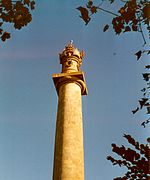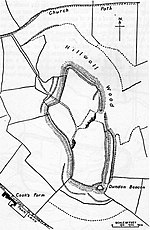Battle of Marshall's Elm
The Battle of Marshall's Elm was a skirmish that took place near Street, in the county of Somerset, South West England, on 4 August 1642. The engagement occurred during the build-up to formal beginning of the First English Civil War on 22 August, while the Royalists and Parliamentarians were recruiting men in the county. The Royalists had established their regional headquarters in Wells, but were threatened by superior Parliamentarian numbers in the vicinity. The Royalist commander sent out a mounted patrol consisting of 60 to 80 cavalry and dragoons, which came across a force of between 500 and 600 Parliamentarian recruits travelling north across the Somerset Levels under the command of Sir John Pyne. The Royalists set an ambush at Marshall's Elm, where the road rose out of the Levels into the Polden Hills. After a parley between the leaders was unsuccessful, the Parliamentarians were caught in the ambush. Facing musket fire from the hidden dragoons, and being charged at by the Royalist cavalry, they were routed. The Royalists killed around 27, and took 60 prisoners, including two of the Parliamentarian officers. Despite their victory, the Royalists were forced to withdraw from Wells, and later from Somerset altogether, due to their inferior numbers.
Excerpt from the Wikipedia article Battle of Marshall's Elm (License: CC BY-SA 3.0, Authors).Battle of Marshall's Elm
Poldon Way,
Geographical coordinates (GPS) Address Nearby Places Show on map
Geographical coordinates (GPS)
| Latitude | Longitude |
|---|---|
| N 51.106944444444 ° | E -2.7375 ° |
Address
Poldon Way
Poldon Way
BA16 0TZ , Compton Dundon
England, United Kingdom
Open on Google Maps









